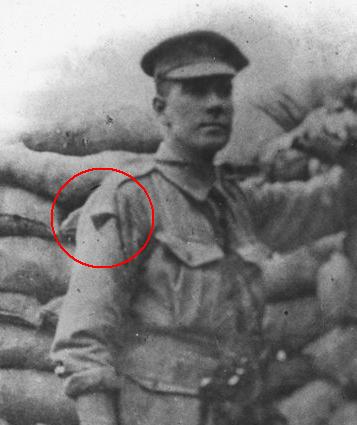Colour patches were worn on Australian soldiers’ uniforms to show which unit they belonged to. For men in the infantry battalions, the colour on the upper part of their patch showed which battalion a soldier was part of, and the lower colour signified their brigade.
Detail from a diagram showing colour patches used in World War I infantry battalions,
from Official history of Australia in the war of 1914-1918, volume 3, published 1929.
(Note that other units such as the Flying Corps, the Light Horse brigades, the Artillery, the Engineers, Transport & Supply and the Medical Corps had their own colours and designs).
Different infantry divisions had different shaped patches:
First Division: rectangle
Second Division: diamond
Third Division: horizontal oval
Fourth Division: circle
Fifth Division: vertical oblong
Sixth Division: vertical oval patch
Someone at headquarters was obviously kept busy thinking up new designs!
These photographs from our Pictures Collection, show soldiers wearing colour patches on their uniforms:
Detail from Portraits of unidentified soldiers taken during World War I, H84.205/79
The 7th regiment Light Horse had a rectangular patch with a black upper triangle and a red lower triangle.
Detail from [Australian soldier in trench], H83.103/282
Second Division colour patch, probably 24th Battalion.
You can find out more about interpreting colour patches in our Australians in World War I research guide. The colour patches section includes a coloured diagram showing many of the infantry patches that were used during World War I.
Written by Barbara Carswell
Librarian, Redmond Barry Team
(Editor’s note: This post was updated on 14 June 2016. Our thanks to commenter David Hamilton for his eagle-eyed corrections!)





Lower image H83.103/282 – 2nd division – 24th Battalion
Upper Image is not 2nd Div. If the photo is the right way around not back to front – this man is most likely Light Horse?
Thanks for the comment David. Yes- you’re right. I think using the online Bean meant the coloured patches were digitised in black and white. I shall amend the entry.
Thanks
Barbara
I’ve got a ww1 cape, belonging to a medical corps soldier, it has over 40 patches inside ie 14RCA,Grenadier Guards,RAMC,OXF.& BUCKS,CanadiamFilm,Reconnaissance,Gameronians,lots of Rats,Bats, Bulldog,Dragons,Flags&Sheilds. I would like more information & value.
Hi Craig. Thanks for you question. We do not undertake valuations, but I have passed your question on to our history librarians, to see if they can assist you in finding more information about the patches. Stay tuned!
Hi again Craig,
Our librarians have emailed you directly, but I am posting a copy of their reply here, for the benefit of other researchers:
This is so helpful. Thank you